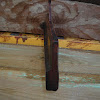adzeman
Established Member
I purchased a wooden moulding plane to day. The chap I bought it off stated it was 18th centuary. I asked how did he know it was 18th centuary? to which he stated he was told by the chap he bought it off.
Taking it home I asked an old carpenter in the village how do you tell how old these old tools are? He informed me that usually they are longer than the more recent planes ie they stick out on the shelf further. He said there are old catalogues which can help but you need a manufacturers name to which mine does not. It has a name stamped on it "Bailey" but I suspect this is a previous owner.
Can any one assist?

It is 10" long
Taking it home I asked an old carpenter in the village how do you tell how old these old tools are? He informed me that usually they are longer than the more recent planes ie they stick out on the shelf further. He said there are old catalogues which can help but you need a manufacturers name to which mine does not. It has a name stamped on it "Bailey" but I suspect this is a previous owner.
Can any one assist?

It is 10" long











































